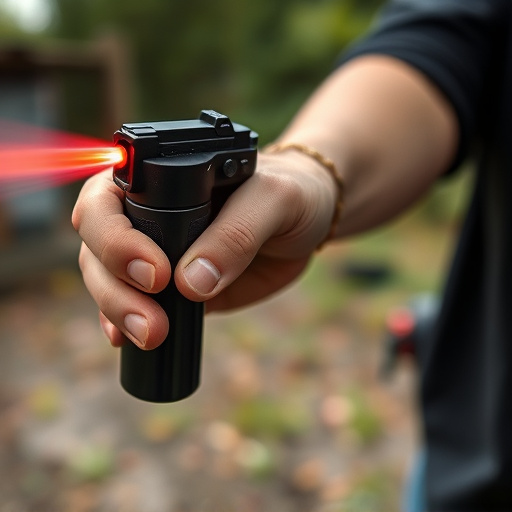Tactical pepper spray, derived from chili peppers, serves as a powerful self-defense tool causing temporary disability without permanent harm. Effective deployment methods include direct spraying into face, eyes, respiratory system or targeting sensitive areas, with proximity to aggressor and user training crucial. Handheld, belt-mounted, and remote spraying techniques cater to different situations, requiring proper technique training and practice. Legal regulations and safety precautions, such as understanding local laws, secure storage, and regular maintenance, are essential for responsible use as a last resort.
“Uncover the power of tactical pepper spray deployment methods with our comprehensive guide. We delve into the science behind oleoresin capsicum spray, offering a detailed understanding of its effectiveness. From tactical application techniques to legal considerations, this article equips readers with vital knowledge. Learn about best practices for optimal results, ensuring safety and legality during use. Discover how the right application method can make all the difference in self-defense scenarios, providing an extra layer of protection.”
- Understanding Oleoresin Capsicum Spray: A Comprehensive Overview
- Tactical Pepper Spray Deployment: Techniques and Best Practices
- Choosing the Right Application Method for Maximum Effectiveness
- Legal Considerations and Safety Precautions When Using Pepper Spray
Understanding Oleoresin Capsicum Spray: A Comprehensive Overview
Oleoresin capsicum (OC) spray, commonly known as tactical pepper spray, is a powerful self-defense tool derived from chili peppers. It works by causing temporary but intense discomfort, leading to a loss of balance and vision in the target individual. This non-lethal weapon has gained popularity among law enforcement agencies, military personnel, and civilians alike for its effectiveness in deterring and disabling assailants without causing permanent harm.
Deployment methods for OC spray vary, with each offering unique advantages in different tactical situations. Common techniques include direct spraying into the face, eye, or respiratory system of an attacker, as well as strategic targeting of sensitive areas like the groin or throat. The user’s proximity to the aggressor and their personal training play significant roles in determining the most effective deployment method. Understanding these variables is crucial for maximizing the safety and efficacy when employing tactical pepper spray as a self-defense mechanism.
Tactical Pepper Spray Deployment: Techniques and Best Practices
Tactical Pepper Spray Deployment is a crucial skill for law enforcement, security personnel, and individuals seeking effective self-defense options. When deployed correctly, pepper spray can disable an attacker temporarily, giving users precious time to escape or summon help. The key to successful deployment lies in understanding various techniques and adhering to best practices.
One common method involves aiming for the face, specifically the eyes, nose, and mouth. This targeted approach maximizes the impact of the spray, causing temporary blindness and respiratory distress. Training in proper technique ensures the user can maintain a safe distance while delivering a powerful, yet controlled, dose of pepper spray. Additionally, practicing deployment under different scenarios, such as moving targets or confined spaces, enhances readiness and effectiveness during real-world situations.
Choosing the Right Application Method for Maximum Effectiveness
When it comes to tactical pepper spray deployment methods, the choice of application technique significantly impacts its effectiveness. For personal defense, understanding various tactical pepper spray deployment methods is crucial. One popular method involves handheld spraying, offering direct control and precision but requiring close proximity to the target. This approach is ideal for neutralizing an aggressor in a tight space.
Alternatively, some users opt for strategic deployment through a belt-mounted or holstered device, enabling hands-free operation. This method allows for quicker reaction times and better mobility during a confrontation. In specific scenarios, advanced deployment mechanisms like aerial or remote spraying can be employed, proving useful in crowd control situations or when dealing with hostile subjects in hard-to-reach areas.
Legal Considerations and Safety Precautions When Using Pepper Spray
When considering tactical pepper spray as a personal defense tool, it’s crucial to understand legal considerations and safety precautions. The use of pepper spray is regulated by local laws, and what is permitted varies widely from one jurisdiction to another. Some areas ban its civilian use altogether, while others allow it only for specific purposes like self-defense or law enforcement. Before deploying any type of pepper spray, individuals should familiarize themselves with local regulations to avoid legal repercussions.
Safety precautions are paramount when handling tactical pepper spray. Users must be trained in proper deployment methods to minimize risk to themselves and others. Pepper spray can cause temporary blindness, breathing difficulties, and severe pain, so it should only be used as a last resort. Storing the spray securely and keeping it out of reach of children and unauthorized individuals is also essential for safety. Regular maintenance and ensuring the product’s expiration date hasn’t been exceeded are additional measures to guarantee optimal performance and safety during deployment.
Oleoresin capsicum spray, a powerful self-defense tool, offers individuals effective protection when deployed tactically. Understanding its composition, proper application techniques, and legal boundaries equips users to make informed decisions in high-pressure situations. By mastering tactical pepper spray deployment methods, individuals can enhance their safety and security while adhering to essential safety precautions.
